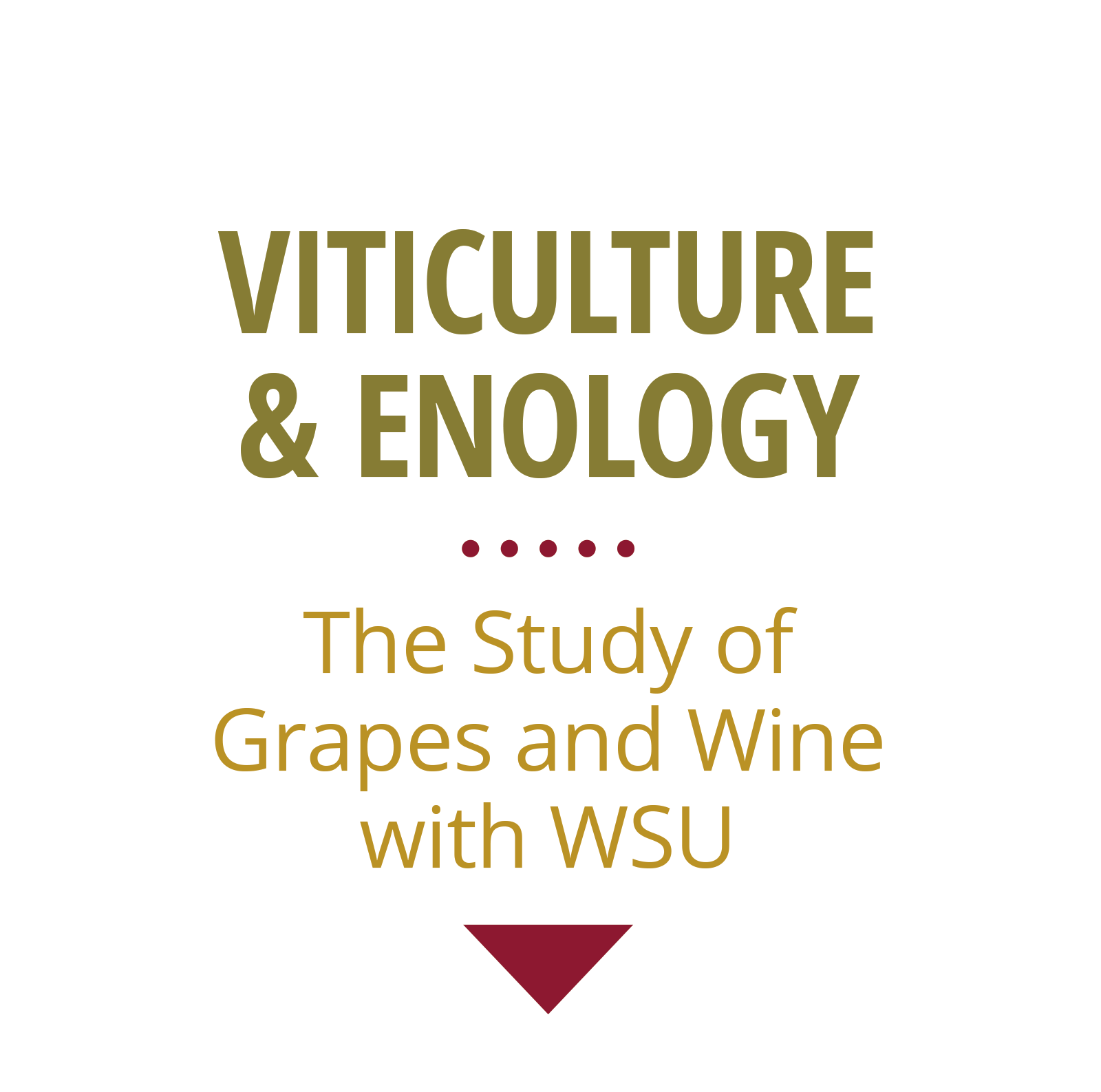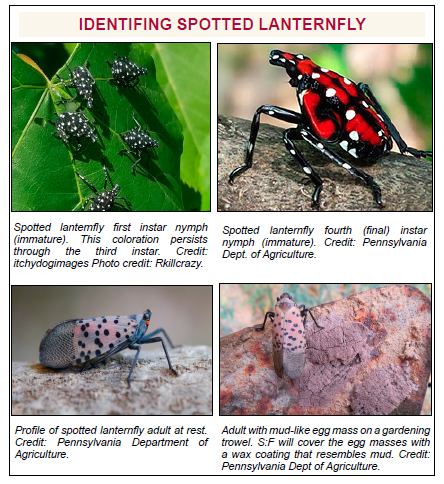This issue of VEEN was originally published as a .PDF in September 2022, and posted online. That issue is now archived, but accessible on the VEEN Archive webpage

VEEN is curated by WSU Viticulture Extension. For questions on articles, or to request to submit an article in future issues, reach out to Michelle Moyer.
A Note from the Editor:
In 2011, we experienced an “uncharacteristically cool and wet” vintage. It was a year that tested our knowledge of both plant disease and wine acid management. Since then, we’ve had many average-to-hot vintages, and topics such as managing mildew, late harvests, and wine acidity have faded into distant memories. But when growing a perennial crop, we need perennial recall; 2022 has more than emphasized this. No need to remember everything though – we have resources on wine.wsu.edu/extension, and in this issue of VEEN to stretch those memory muscles as we all patiently await the arrival of harvest.
On a happy note, the newly minted Department of Viticulture and Enology at WSU has welcomed our inagural Chair: Dr. Jean Dodson-Peterson. Join WSU and the Washington State Wine Commission or a series of meet-and-greets in October and November. For more details and to RSVP, please visit: https://wsu.co1.qualtrics.com/jfe/form/SV_79bHtASokIlLnmK
Michelle M. Moyer
Viticulture Extension Specialist
WSU Prosser IAREC
Check out these two USDA-NIFA-SCRI Grape Research Projects out of WSU!
- Fungicide Resistance Assessment, Mitigation and Extension Network for Wine, Table and Raisin Grapes (FRAME)
- High Resolution Vineyard Nutrition Management (HiRes)
Table of Contents
Spotted Lanternfly: If You Spot It, Swat It (and Report It)!
Author: Cassie Cichorz, Washington State Department of Agriculture
relatively new invasive pest to the United States, is native to Asia. Should it become established in Washington, SLF could threaten many Washington iconic crops, such as grapes, hops apples and other tree fruits, and result in costly quarantines and increased pesticide use to manage the pest.
Currently, SLF is established in the northeastern United States, although it has been found dead in Oregon as a hitchhiker on goods shipped from the northeast. More alarmingly, more than fifty spotted lanternflies have been found both alive and dead in California at state border agricultural inspection stations as well as on cargo flights.
Entomologist Sven-Erik Spichiger spent a decade as Pennsylvania’s state entomologist. He knows how bad the infestations can be from experience. “When you’ve seen tens of thousands of spotted lanternflies on an apple tree during harvest, it will turn your head around,” Spichiger said.
Damage incurred by SLF includes oozing sap, wilting, leaf curling, and plant dieback. When SLF feeds on plant sap, it secretes sticky droplets of honeydew that rain down from SLF-infested plants. This honeydew production is so voluminous, in some cases, people need raincoats to work in the area. The shellac of honeydew turns rancid over time and attracts swarms of bees, ants, and wasps. Finally, the honeydew coated understory becomes black with “sooty mold.”
Most adult SLF are bad fliers and will be found with their wings closed. Adults begin to lay grey-brown egg clusters in September on many types of outdoor surfaces, from bark to stonework to field tools.
Spotted lanternfly looks drastically different in its various stages of development. Learn to recognize these different forms (see Identifying Spotted Lanternfly, below) and report them if you see them. Spotted lanternfly is likely to infest the invasive tree-of-heave when it (SLF) arrives. For information on identifying the tree-of-heaven, visit: https://www.nwcb.wa.gov/weeds/tree-of-heaven
Identifying Spotted Lanternfly
- 1’’ long, ½’’ wide at rest
- Yellow and black banded abdomen
- Black head and legs
- Light gray forewings with black spots and a rear speckled band
- Scarlet hindwings with black spots and rear black and white bars
Reporting Spotted Lanternfly
When reporting possible SLF sightings, include a photograph, date, and location of the sighting and – most importantly – collect the suspect insect or egg mass. Reports can be made using the Washington Invasive Species Council’s (WISC) online reporting form or mobile app. Visit https://invasivespecies.wa.gov/ to learn more about reporting.
“This is another example of the important role everyone plays in stopping invasive species,” said Justin Bush, WISC’s executive coordinator. “If you spot a suspected invasive species, immediately notify the council through our website or phone app. You may be reporting a new invasive species and help prevent millions, if not billions, of dollars in damage and loss.”
Irrigation Scheduling by Wine Grape Variety: Hints from Research
Authors: Charles Obiero and Markus Keller, WSU Prosser
environments due to climate change make efficient irrigation management an important issue for sustaining water economy and wine grape production. Although irrigation in wine grape production in Washington State is progressive and water conserving because of deficit drip irrigation [1; 2], little information is available to guide growers with regards to irrigation scheduling for individual varieties.
Irrigation scheduling is usually based on one or a combination of four methods to estimate the frequency and amount of periodic water replenishment: (1) More or less frequent visual observations of canopy growth and fruit development; (2) Use of evapotranspiration data from weather stations, coupled with a crop coefficient roughly reflecting canopy size; (3) Intermittent or continuous monitoring of soil moisture depletion and refilling; or (4) Periodic measurements of plant water status using pressure chambers or porometers.
Nonetheless, growers often observe peculiar behaviors of some varieties that can make irrigation management somewhat unclear. This study aimed to optimize vineyard irrigation management by wine grape variety. Specifically, we investigated if irrigation scheduling for different varieties could simply be conducted through canopy size. If so, how? And what other simple tools are at a grower’s disposal?
We conducted a field trial in 2021 and 2022 in a drip-irrigated research vineyard planted in 2010 at WSU Prosser IAREC to understand the responses of 30 wine grape varieties to imposed water deficit (Table 1). In each season, varieties were fully irrigated through bloom, then the soil was subjected to two dry-down cycles to create a gradual soil water deficit. The first cycle began at fruit set and the second at veraison following irrigation to replenish soil moisture to near field capacity.
 We estimated the canopy size of each variety at fruit set, veraison, and during winter pruning. We took weekly measurements of soil moisture (by neutron probe) as well as fortnightly measurements of midday leaf water potential (Ψleaf; by pressure chamber) throughout the growing season.
We estimated the canopy size of each variety at fruit set, veraison, and during winter pruning. We took weekly measurements of soil moisture (by neutron probe) as well as fortnightly measurements of midday leaf water potential (Ψleaf; by pressure chamber) throughout the growing season.
For simplicity, we show results for 14 varieties: 2 varieties with known divergent responses to soil moisture deficit (Grenache and Sémillon); 5 major wine grape varieties in Washington (Cabernet Sauvignon, Merlot, Chardonnay, Riesling, and Sauvignon blanc) and 7 varieties with different vigor (Albariño, Aligoté, Durif, Nebbiolo, Melon, Malbec, and Tempranillo) (in bold in Table 1).
To allow comparison of soil water deficit across different soil types, we converted volumetric soil water content (VWC) to extractable soil water (ESW), defined as the relative water content normalized to field capacity (FC) and permanent wilting point (PWP) [3] as follows:
ESW=(VWC-PWP)/(FC-PWP)
The VWC at FC of the vineyard is 30% and PWP 7%.
Lastly, we estimated the ESW at which each variety’s midday Ψleaf was at -1 MPa (considered as the start of moderate water stress [4]).
Heat waves (temperatures above 95°F) were experienced during the first dry-downs in both years (Fig. 1). In 2021 (Fig. 1a), the soil dried down more quickly compared to the same period in 2022 (Fig. 1b). This is probably because the “heat dome” in late June of 2021 caused rapid water evaporation from both the canopy and the soil. In the second dry-down of 2021, temperatures were cooler, and days were getting shorter. Therefore, the soil dried down much slower. The ESW showed the same pattern for the two depths in 2021, but in 2022 water seemed to be extracted more quickly from the 12 inch depth.

The varieties differed in shoot growth, and this was consistent in the two growing seasons. Nebbiolo, Tempranillo, and Albariño were more vigorous compared with any of the five major varieties grown in Washington, although Riesling was more vigorous in 2021 than in 2022 (Fig. 2). Durif, Aligoté, and Melon were the least vigorous.
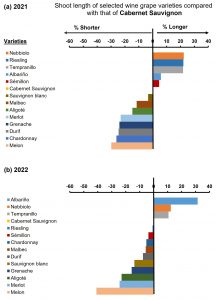
Varieties with bigger canopies had between 10% to 30% longer shoots, and those with smaller canopies had 10% to 40% shorter shoots, compared with Cabernet Sauvignon. Unlike in 2021, the wet spring in 2022 caused most varieties to grow shoots to more than 4 feet in length.
Varieties responded differently to soil water deficit. Melon, Sémillon, Cabernet Sauvignon, Chardonnay and Durif had midday Ψleaf of -1 MPa (transition from mild to moderate water stress) at ESW values between 0.15 and 0.2 (Fig. 3).
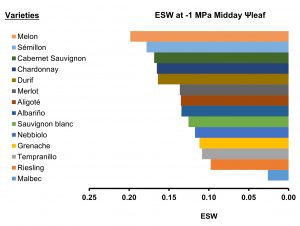
The ESW of Merlot, Aligoté, Albariño, Sauvignon blanc, Nebbiolo, Grenache, Tempranillo, and Riesling at midday Ψleaf = -1 MPa was between 0.1 and 0.15 and Malbec below 0.1. Varieties with lower ESW numbers apparently did not experience water stress until the soil had dried down to lower levels compared with varieties with higher ESW numbers. For example, varieties such as Malbec may require significant soil dry-down to achieve the benefits associated with moderate water stress. There was no clear indication that these ESW thresholds were related to shoot length, except that Melon stands out as experiencing moderate water stress at the highest soil moisture, which may explain why it was the least vigorous variety. Shoot growth in grapevines is thought to stop at stem water potentials of about -1 MPa [5]. However, varieties with bigger canopies dried the soil more quickly (Figs. 4, 5). Therefore, it is likely that vigorous varieties, such as Tempranillo, reached this level of water stress faster than those with smaller canopies, such as Durif.

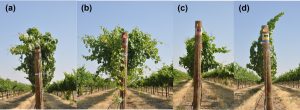
Taken together these results mean:
- Shoot length / canopy measurement is a simple tool that can be used in irrigation scheduling for different varieties. Vigorous varieties dry the soil more quickly and might need more frequent irrigation once control of shoot growth has been achieved, especially during heat waves.
- Wine grape varieties respond differently to water deficit. There are those with higher (0.15-2.0), medium (1.0-0.15), and lower (below 0.1) extractable soil water thresholds at which plant water stress starts. But to use this tool, growers need to know the soil’s field capacity and permanent wilting point.
- Generally, the type of wine grape variety (either white or red wine grape) is unimportant with respect to responses to soil water deficit. However, deficit irrigation goals and scheduling can be tailored depending on specific wine styles and quality parameters.
Acknowledgements
Washington State Department of Agriculture Specialty Crop Block Grant Program, Washington State Grape and Wine Research Program, and Ancora Estate (Ciel du Cheval Vineyards) supported this work.
References
- Casassa LF, Keller M, Harbertson, JF. Regulated deficit irrigation alters anthocyanins, tannins and sensory properties of Cabernet Sauvignon grapes and wines. Molecules. 2005;20(5):7820-7844.
- Keller M, Romero P, Gohil H, Smithyman RP, Riley WR, Casassa LF, Harbertson JF. Deficit irrigation alters grapevine growth, physiology, and fruit microclimate. American Journal of Enology and Viticulture. 2016;67(4):426-435.
- Van Leeuwen C, Trégoat O, Choné X, Bois B, Pernet D, Gaudillère JP. Vine water status is a key factor in grape ripening and vintage quality for red Bordeaux wine. How can it be assessed for vineyard management purposes? Oeno One. 2009;43(3):121-134.
- Gerakis A, Zalidis G. Estimating field-measured, plant extractable water from soil properties: beyond statistical models. Irrigation and Drainage Systems. 1998;12(4):311-322.
- Schultz HR, Matthews MA. Vegetative growth distribution during water deficits in Vitis vinifera L. Functional Plant Biology. 1998;15(5):641-656.
Vineyard Soil Health – New Vineyard at WSU Prosser IAREC!
Author: Devin Rippner, USDA-ARS, Prosser
Soil health is a popular concept that seeks to incorporate soil biology into soil management frameworks. At the core of soil health is the ability of soils to maintain their optimal function to meet specific context-dependent goals.
From a soil health perspective, the soils of eastern Washington are unique. They are relatively coarse textured (coarse sand to silt loam) with low clay content, have little organic matter and high pH, receive little rainfall, and often have significant accumulations of salts and carbonates in the plant root zone. As such, they would be considered unhealthy by almost all established soil health metrics.
These metrics, however, are not appropriate for evaluating our soils. They were developed on the US East Coast and are typically used to evaluate soils in the Midwest commonly planted to row crops.
To better understand how to evaluate soil health for eastern Washington specialty crops, scientists at the Washington State University Irrigated Agriculture Research and Extension Center are establishing a wine grape vineyard (~5 acres) to study the long-term influence of vineyard management practices on soil health and grape quality.
Cabernet Sauvignon and Chardonnay will be grafted to 1103P rootstock, and planted in 2023. Five ground / soil management approaches will be evaluated. These approaches were developed in collaboration with a research advisory group composed of industry professionals.
Management treatments will be:
- Control: Conventional fertilizer and herbicide practices.
- Conventional fertilizer practices with mowing rather than herbicide for weed control.
- In-vine row leguminous cover crop with conventional fertilizer practices and mowing for weed control.
- Compost-based fertilization with mowing for weed control.
- A yet-to-be finalized soil amendment with conventional fertilizer practices and mowing for weed control.
Treatments will be distributed in such a way to allow movement of pollinators (for potential cover crops) throughout the vineyard. We hypothesize that measured soil health metrics will improve in treatments that retain plant cover and receive compost fertilization, minimizing soil disturbance and maximizing soil organic carbon accumulation.
At the time of writing, site preparation is underway with a late summer cover crop of forage radish, a nematode trap crop, recently planted (Fig. 1). After vineyard establishment, soils in the vine row and alley will be sampled to evaluate differences in soil health metrics initially and over time. This is important as the alleys will be compacted during planting, altering many of the important soil health metrics.
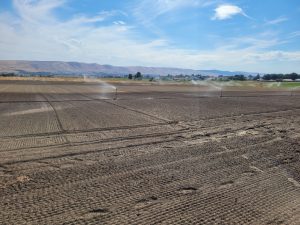
Over time, we anticipate soil health metrics between the two locations will diverge due to differences in soil management. Baseline soil health characterization will include: pH, electrical conductivity, bulk density, total carbon, total organic carbon, total nitrogen, potentially mineralizable carbon, and permanganate oxidizable carbon, as well as other important metrics. In addition, soil microbial and nematode communities will be characterized. Collected soils will be archived for future analysis.
Updates will follow as the vineyard is installed and data is collected.
Wine Research Tackles High Priority Issues
Author: Melissa Hansen, Research Program Director, Washington State Wine Commission
Sustainability is predominant theme of research approved by Washington State Wine this year.
The Washington State Wine Commission awarded about $1 million in research grants for 2022-23 through the statewide grape and wine research program and its own grant program. While the overall objective of research is to improve wine quality by addressing high priority vineyard and winery issues, sustainability is a major theme of the research projects for 2022-23.
Of the 25 research projects currently underway, 10 projects or 40 percent are related to sustainability. The goals of these sustainability projects include developing more sustainable pest management strategies for key insects and diseases; improving sampling protocols and improving efficiency for vineyard nutrient management; and optimizing irrigation efficiencies.
Why the focus on sustainability? For one, Vineyard Sustainability was ranked as the top research priority in the 2022 Washington Wine Industry Research Survey. The survey is conducted annually by the Washington State Wine Commission to receive industry feedback on research priorities. For the first time since the annual survey began in 2016, Vineyard Sustainability (vineyard floor, soil fertility, carbon sequestration, nutrient management, rootstock management and selection) was rated as the most important vineyard research topic. Pest Management, which was a very close second, traditionally ranks as highest priority.
Cutting-edge technologies and sustainable management strategies now under development by Washington State University scientists will help keep Washington wine grape production competitive in the future. These innovative tools will also be used by wine grape growers participating in the new Sustainable WA certification program launched earlier this year.
Sustainable Spotlight
Below is a summary of a few sustainable research projects underway:
Impact of Mycorrhizal Inoculants on Grapevine Growth – Dr. Tanya Cheeke, WSU microbial ecologist, is comparing commercially available mycorrhizal inoculants with locally adapted mycorrhizal fungi to determine if there is increased grapevine plant growth and nutrient uptake from locally adapted mycorrhizal fungi. The first phase of her research showed that mycorrhizal inoculants increased phosphorus uptake by young grapevines and young vines treated with inoculants had increased root and biomass, but that there were varietal differences.
Monitoring Grape Leafhopper Parasitoids – Dr. David James, WSU entomologist, is studying if Anagrus parasitic wasps are attracted to eugenol, a newly identified sex pheromone of an Anagrus species in Europe. Anagrus wasps are important biological control agents of grape leafhoppers in Washington. Eugenol is extracted from essential oils, including clove, nutmeg and cinnamon. This summer, James conducted field tests with vials of eugenol and clove oil and sticky traps to learn if the Anagrus wasps are attracted to the oils. The work could lead to a more reliable way to monitor the presence of parasitoid wasps in vineyards in early season, which could lead to better informed, season-long leafhopper management planning.
Combining Drones and Attractants to Improve BioControl – Manual release of biological control agents, such as beneficial bugs and predators, is labor intensive and difficult to implement in large areas. And there’s always the question of do the good bugs stay in the vines or leave? WSU Entomologist Dr. David James is collaborating with the private company UAV-IQ to study the value of using drones to release commercially reared predators of grape mealybug and spider mites. The trial includes placing sachets of methyl salicylate in the vineyards to learn if the attractant further enhances drone-applied beneficials. Previous work with methyl salicylate showed it helped attract beneficial arthropods in the field.
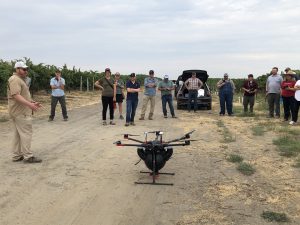
Alternative Strategies for Nematodes – Dr. Michelle Moyer, WSU statewide viticulture extension specialist, is in the final year of evaluating the value of using cover crops to trap or trick root-knot nematodes and reduce their populations in replant situations. She is also studying fallow periods to suppress nematode populations before replanting.
Alternative Management of Grape Powdery Mildew – Alternative ways to manage powdery mildew would give growers more tools to manage the foliar disease and manage fungicide resistance. WSU’s Dr. Michelle Moyer is investigating how to best use UVC light to control grape powdery mildew. The trial uses a custom-built, over-the-row UVC light device to test application timing and frequency. The technique, developed by Cornell University’s Dr. David Gadoury, has proven effective in strawberries and grapes grown under high mildew pressure.
Grape Mealybug Management – Grape mealybug, the primary vector of grapevine leafroll virus, has proven difficult to control with traditional pesticides. Resistance to insecticides has been found in some grape mealybug populations in Washington. Dr. Doug Walsh, WSU entomologist and statewide IPM coordinator, is studying the use of sex pheromones to disrupt the mating of grape mealybug and slow its spread through vineyards. Preliminary studies show the technique has great promise.
Efficient Vineyard Nutrition – Vineyard nutrient management is critical to reach sustainable production-specific quality standards, but growers can’t quickly or easily assess grapevine nutrient status. Standard sampling protocols lack precision or relevancy for the diverse production goals of the grape industry and most tissue nutrient status thresholds were developed in 1960s and 1980s from California data—before the introduction of deficit irrigation. Previous work of Dr. Markus Keller, WSU viticulturist, found that deficit irrigation alters nutrient uptake of grapevines. This project aims to optimize the sampling protocols for grapevine tissue analysis and determine how quickly grapevines respond to nutrient adjustment. Results will be integrated into nutrient management recommendations and serve as a basis to develop smart technology for remote nutrient status monitoring.
Sensor-based Irrigation Scheduling – Dr. Pete Jacoby, WSU plant ecologist, is evaluating two types of soil water sensors to enhance irrigation efficiency: one measures soil water that is available to the vine; the second measures the total soil water content (available and soil bound). By quantifying both soil water content and soil water availability, a wine grape grower could potentially create a more stable level of deficit irrigation.
Soil Health – A long-term research experiment was initiated this year by Dr. Devin Rippner, USDA soil scientist. A variety of treatments will be conducted to investigate the role that vineyard management practices have on soil health metrics. The project, funded by the Washington State Wine Commission and WSU’s Soil Health Initiative, will quantify the effects of mowing, cover crops, compost and alternative irrigation strategies on soil health, grape quality and vine health. Data from the project will be used to establish best practices for improving vineyard soil health for long-term sustainability and improved grape quality. A six-acre block of wine grapes will be planted and dedicated to this project.
Sustainable WA
Earlier this year, the Washington wine industry launched Sustainable WA, the first statewide, certified sustainability program built specifically for Washington vineyards. The program signifies the industry’s commitment to quality fruit, environmental stewardship and healthy communities.
As new issues challenge wine grape growers and wineries, the WSU research team will continue to work closely with the Washington wine industry to provide the tools and solutions needed to keep Washington’s wine grape growers and wineries competitive and sustainable.
To learn more about the Washington wine industry’s research program, visit: https://www.washingtonwine.org/research-innovation/
